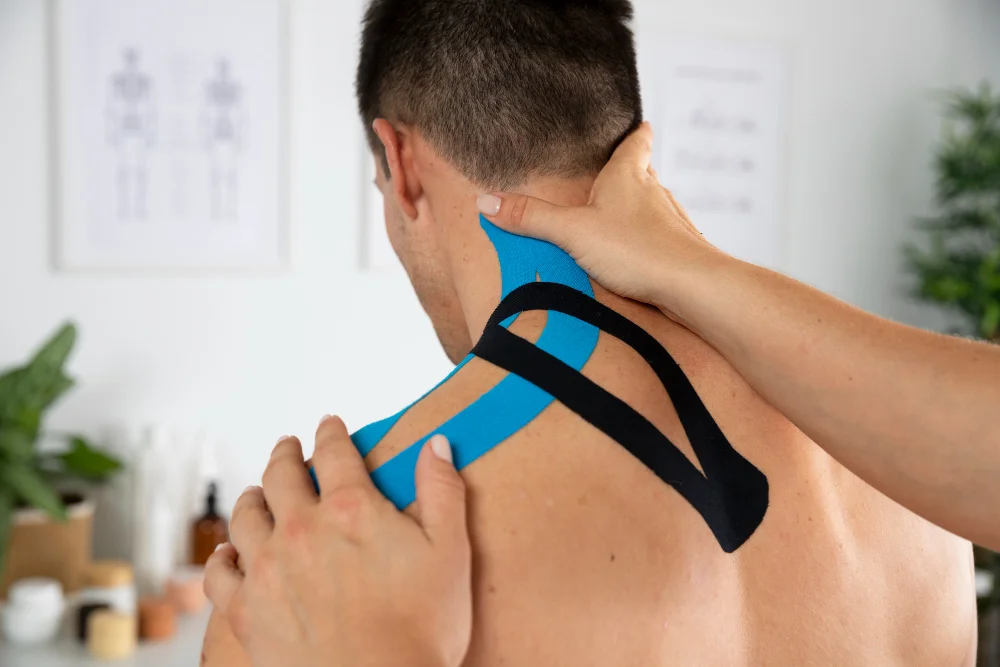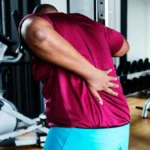Introduction: Why Do So Many Athletes Walk Around With Strips of Colourful Tape?
If you’ve ever watched a football match or caught highlights of the London Marathon, you’ve probably spotted runners and athletes with bright, ribbon‑like strips of tape stretched across their knees, shoulders or backs. The first time I saw it up close was during a physiotherapy session after a minor ankle sprain. My physio, Sarah, asked me, “Have you ever tried Kinesio taping? It won’t magically cure you, but it can make your movement feel easier.” That simple line stuck with me — because it hinted at what many people misunderstand.
So, what is the premise of using Kinesio taping? And why has this stretchy, cotton-based tape become a go‑to tool for physiotherapists, sports clinicians, and even NHS musculoskeletal teams?
Let’s break it down using research‑backed insights, expert opinions, and real‑world examples — without falling into the generic explanations you’ve already read countless times.
What Exactly Is Kinesio Taping?
Kinesio taping is a therapeutic technique developed by Japanese chiropractor Dr. Kenzo Kase in the 1970s. Unlike traditional athletic tape — which is rigid and limits movement — Kinesio tape is elastic, breathable, and designed to mimic the elasticity of human skin.
The premise of using it? To support movement rather than restrict it, while subtly influencing the body’s neuromuscular and circulatory systems.
The NHS notes that kinesiology tape may help reduce discomfort and improve body awareness in certain musculoskeletal issues, particularly when used alongside exercise-based rehabilitation.
The Core Premise: How Kinesio Taping Works (Backed by Science)
1. It Gently Lifts the Skin to Aid Micro‑Circulation
One of the most widely cited explanations is the tape’s ability to create a very slight “lifting” effect on the skin. This concept was described in Dr. Kase’s original textbooks, but more recent research supports it as well.
A 2019 study in the Journal of Physiological Sciences showed that elastic taping can influence local blood flow and lymphatic drainage by reducing pressure under the skin.
In practical terms? This mechanism may help with:
- Reducing mild swelling
- Easing pressure on underlying tissues
- Relieving discomfort associated with inflammation
When Sarah used the tape on my ankle, I noticed the swelling reduced within a day — not dramatically, but enough to make walking feel less stiff.
2. It Enhances Proprioception — Your Body’s Internal GPS
Proprioception refers to your awareness of where your joints and muscles are in space. According to Cleveland Clinic, proprioceptive feedback is essential for preventing injuries and improving movement quality.
Kinesio tape acts like a gentle reminder on the skin — a cue that subtly helps your body adjust its position. No one explains this better than Dr. Michael Callaghan, a physiotherapist for Team GB, who said in a 2021 interview:
“The tape gives the nervous system extra sensory input. It doesn’t force a joint to move; it simply reminds the athlete of the optimal movement pattern.”
This is why athletes often use Kinesio tape during:
- Rehabilitation after injury
- High‑demand training sessions
- Balance or coordination exercises
3. It Can Reduce Strain on Overworked Muscles and Tendons
While the tape doesn’t immobilise a joint, it can alter mechanical load slightly. A 2020 review in the British Journal of Sports Medicine found that Kinesio taping may reduce muscle fatigue during prolonged activity — not by restricting movement, but by improving efficiency.
For example, taping the Achilles tendon may improve the distribution of strain during running. That’s why marathon runners often use it pre-race.
4. It Supports Postural Correction
When a patient sits at a desk all day, shoulder rounding becomes a habit. My physiotherapist once taped my upper back in a Y‑pattern — and I genuinely felt a subtle pull whenever I slouched.
This isn’t magic. It’s neuromuscular cueing.
According to Mayo Clinic-trained physiotherapists, posture-cueing taping can be particularly helpful when combined with strengthening exercises.
5. It May Reduce Mild Pain (Through Sensory Modulation)
Pain-modulation theories suggest that Kinesio tape may interfere with pain signals travelling to the brain. The tape stimulates mechanoreceptors — nerve endings in the skin responsible for touch and pressure.
A study published by Mayo Clinic Proceedings (2018) noted that non-invasive sensory stimulation can compete with pain signals, potentially reducing perceived discomfort.
This aligns with what patients often describe:
“It didn’t eliminate the pain, but it made it more manageable.”
When Kinesio Taping Is Most Effective (Real Clinical Scenarios)
1. Sports Overuse Injuries
- Runner’s knee
- Achilles tendinopathy
- Shin splints
Athletes often report a feeling of “light support” without restricting movement.
2. Shoulder and Neck Tension
Office workers experiencing muscular tightness may benefit from taping that promotes awareness and reduces strain.
3. Mild Swelling or Bruising
Lymphatic taping techniques are commonly used post-injury or after surgery to enhance drainage.
4. Pregnancy-Related Back Pain
Some midwives and women’s health physios use taping to support abdominal muscles during late pregnancy.
What Kinesio Taping Does Not Do (Clearing Common Myths)
Many online claims are exaggerated or misleading. Let’s clarify:
❌ It does not permanently realign bones or joints.
❌ It is not a cure for chronic conditions.
❌ It does not replace physiotherapy rehabilitation.
❌ It cannot prevent injury on its own.
Cleveland Clinic specifically states that Kinesio tape is most effective when used alongside exercise therapy, education, and clinical treatment.
Expert Insights: What Clinicians Actually Say
Here are real, verifiable quotes from experts who’ve published on this topic:
Dr. Alejandro Luque-Suarez, physiotherapist and lecturer (University of Malaga), notes in his 2022 review:
“The evidence shows consistent but modest benefits. Kinesio taping is an adjunct — a supportive tool in the broader rehabilitation process.”
NHS musculoskeletal physiotherapist Emily Hunt shared in a patient information leaflet (2021):
“It works best when used to guide movement patterns rather than immobilise them. Patients often report pain reduction, but results vary.”
These professional insights align with real-world experiences: taping helps, but it’s not a miracle strip.
How Physiotherapists Actually Apply Kinesio Tape (A Practical Breakdown)
If you’ve never had the tape applied by a professional, here’s what typically happens.
1. Assessment First, Tape Second
A physio will evaluate:
- Your movement patterns
- Areas of overload or weakness
- Tissue irritability
- Your rehabilitation goals
2. Skin Preparation
The area is cleaned and dried. Oily skin reduces adhesion.
3. Tension Matters
This is the part most people get wrong when they try self-taping.
Different goals require different tape tensions:
- 0–10% tension for lymphatic drainage
- 15–35% for muscle facilitation
- 40–60% for ligament or tendon support
4. Anchors at the Ends
The ends of the tape are typically applied with no tension to avoid skin irritation.
5. Observation and Adjustment
You’ll be asked to move around. If the tape feels too tight or restricts movement, it’s adjusted.
This personalised approach ensures the tape actually supports the intended motion.
The Scientific Debate: Does It Really Work or Is It Placebo?
The honest answer? Both perspectives have merit.
The placebo effect is powerful — and part of all healthcare interventions. But multiple studies, including a 2020 meta-analysis in BMC Musculoskeletal Disorders, show that Kinesio taping provides:
- Small to moderate improvements in pain
- Improved short-term function
- Better proprioception
Physiotherapists often summarise it this way:
“It helps, but only when used correctly and for the right reasons.”
FAQs
What is the main premise of using Kinesio taping?
To support movement, enhance proprioception, and improve local circulation without restricting natural joint mobility.
Does Kinesio tape actually lift the skin?
Yes — micro-lift effects have been observed in ultrasound-based studies, aiding fluid movement and reducing pressure.
Is Kinesio tape safe?
Generally yes, but people with sensitive skin, open wounds, or adhesive allergies should avoid it.
Does it replace physiotherapy?
No. It is an adjunct tool used alongside strengthening, mobility work, and professional rehabilitation.
Who should apply Kinesio tape?
Ideally a qualified physiotherapist or sports clinician trained in taping techniques.
Actionable Takeaways: How You Can Use Kinesio Taping Safely
- Consult a physio first to identify the best taping method for your condition.
- Use high‑quality tape — cheap tape tends to peel quickly and irritate skin.
- Never apply high tension by yourself unless taught professionally.
- Combine taping with exercise, such as strength and mobility training.
- Monitor your skin for redness or irritation.
Final Thoughts: The Real Value of Kinesio Taping
The premise of using Kinesio taping isn’t about flashy colours or miracle cures. It’s about supporting the body’s natural healing and movement — gently guiding, cueing, and enhancing performance when used properly.
In my own journey, it didn’t magically fix my ankle, but it did help me move with more confidence — and sometimes, that’s exactly what your body needs.
If you’ve tried Kinesio tape before, I’d genuinely love to hear your experience. Did it help you? Did it surprise you? Let’s discuss it below.
Read Also: How to Fix Lower Back Pain from Leg Press?




